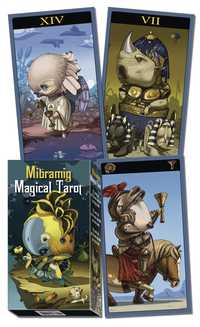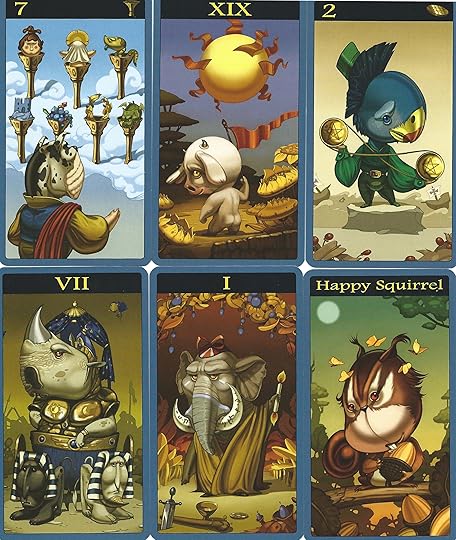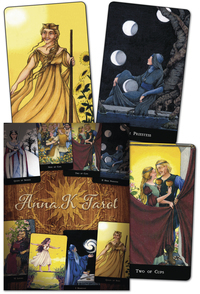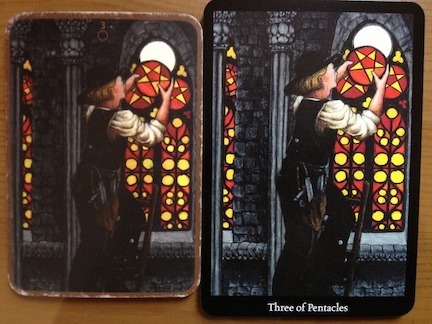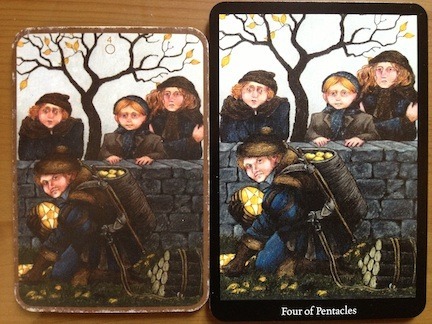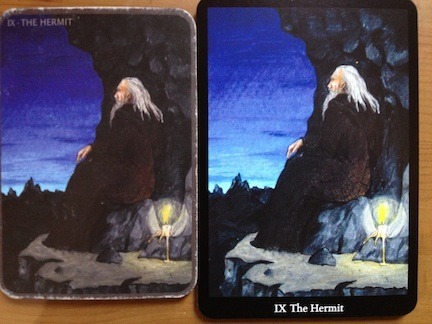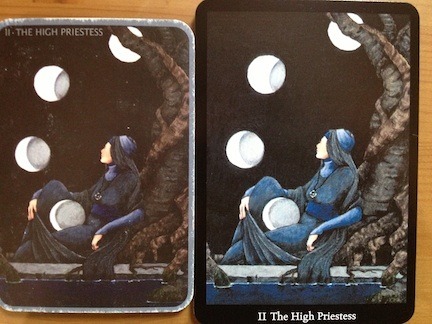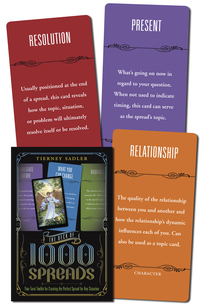Llewellyn Publications's Blog, page 95
March 15, 2013
Throw Out the LWB?
One of the blogs I like to read is by Alan Joel, called the Esoteric School of Shamanism and Magic Blog. In his most recent post he advises that when you get a new Tarot deck you should “throw away the book that comes with the Tarot deck.” By that I assume he means the “Little White Booklet” (LWB) that often comes inside a box of Tarot cards. More and more decks are coming with larger booklets or even full-sized books, and I’m going to guess (I could be wrong) he doesn’t mean those.
Often, the LWB provides the most minimal of information. So to my mind it would be better not to throw out the LWB, but rather to study it in conjunction with other books or courses on the Tarot. Joel does say that you have to know the meaning of the card and implies that it has multiple levels (I’d agree), and that in a reading, the position of a card in relation to the other cards influences the meaning. I agree.
However, I would respectfully disagree with the concept of throwing out the LWB. There is an enormous growth in number of Tarot decks available today, often with unique and original designs. Some have symbolism and meanings that go in different directions than the Rider-Waite-Smith tradition. There’s even a growing tradition that includes a new card, “Happy Squirrel,” that started out as a joke on “The Simpsons” animated cartoon show and is becoming popular with some Tarot users. Without some sort of information a reader might not know what to do with this card.
The Map is not the Territory
The statement in the headline above is a presupposition used in Neuro-Linguistic Programming (NLP). It’s meaning is that a map is not the territory itself, it’s just a model of the territory. The closer the map is to being the actual territory, the more accurate it is.
Similarly, our individual understandings of the universe and the world around us form our personal map of reality: what we believe and think is a map, not the actual territory; it’s our truth and not the truth.
Say you’re driving and someone speeds ahead of you and cuts you off. “What a thoughtless idiot,” you think. So your map of the person is that he’s a thoughtless idiot. However, what you don’t know is that lying in his back seat is his dangerously ill child, and all he can think of is doing anything to get the child to the hospital. So is he a “thoughtless idiot” or “someone trying to save a life?” I’d say he’s both. Both descriptions are just maps of the actuality, the real territory.
In his blog Joel writes,
the Tarot is a small mini-version of the Universe so knowing the real tarot card meanings is important.
Wow. That simple sentence surprisingly has a lot to analyze. First, I somewhat agree that “the Tarot is a small mini-version of the Universe.” But so are you and I (we’re each the “microcosm” to the universe’s “macrocosm”) and so are the rules of physics, astrology, psychology, and many other things. Each is just a map and gives an incomplete view of the actual universe. Each is useful in different ways.
The word “so” is used in the quote to link the two clauses. It’s a form of what NLPers call one of the language patterns of the Milton Model. In NLP jargon it’s called “cause and effect.” In NLP (and in hypnotherapy) we use this technique to help encourage results. “You’re sitting in that chair so that means you want to make a change in your life.” It seems to make sense, but the clauses are actually unrelated. It’s the use of cause and effect presented seemingly reasonably to the mind even though the cause is not actually related to the effect.
The same is true with Joel’s statement. Just because the Tarot can be seen as a mini-version of the universe doesn’t mean knowing real Tarot card meanings is important. There is no real cause and effect here, but it’s used to imply it. In fact, if you accept either part of the sentence, the implication is that you also have to accept the other half. I congratulate Joel on his excellent use of language patterns. Well done.
However, if we take a step back, we see that not only is there no true cause and effect relationship, but he makes a claim that there is a “real tarot [card] meaning.” In the language patterns of the NLP Milton Model this is known as a “Lost Performative.” This is when we apply a value judgement (in this case the judgement is that a particular Tarot card meaning is “real” implying that other meanings are not real) where the determinant of the value judgement is omitted. Here, we’d have to ask, “who says what is real?”
So this simple sentence is actually a complex bit of written manipulation and is done very well.
Did You Say, “Manipulation?”
Yes, I did say that. The concept of manipulation has an incredibly bad reputation. The truth, however, is that we manipulate people every day. “Pass the salt” is a form of manipulating someone to do something they hadn’t planned on doing. “Brush your teeth” is a form of manipulating someone to do something that’s good for them. Manipulation can be good, indifferent, or negative. In Joel’s case he’s using his writing skills (either as a result of training or instinctively) to convince you that he’s correct. We all do this to varying degrees, and his work, here, is very good.
The thing is, if you analyze what he’s writing, he gives the idea that there is a real meaning to Tarot cards, but the meanings change depending upon the position in a layout and the card’s relationship to other cards. So if the “real” meaning of the Tarot card changes, who determines the meaning at any particular time? Would that be Joel? My guess is that he would deny it, but that is certainly the implication of what he’s doing. But is he, or anyone else, right?
When Death isn’t Death
Joel writes, “ the Death card does not mean physical death.” Generally, that’s true. But after giving thousands of readings, I’ve discovered that on rare occasions it exactly means a physical death. So I would suggest that his interpretation here is usually “real” but not always so.
He continues, “Traditionally in magical and mystical circles, death represents a major, usually sudden, unexpected ending and beginning.” I would respectfully disagree. It is the Tower card that represents sudden and unexpected changes (ending and beginning). The Death card represents positive evolutionary change, like a caterpillar dying so a butterfly can live.
Joel further writes, “Although it [the Death card] usually applies to something unexpected, it can also apply to something expected. It can be making a real positive shift or a real negative one, depending on how it shows up in the reading layout, but either way, it is a major happening in the spiritual realm, to the being as a spirit. It may or may not affect the physical level…” So it’s unexpected or expected, a positive or negative shift, and it happens on the spiritual level and may or may not affect the physical level. Whew! That really leaves a lot of openings to mean just about anything.
Joel present a meaning of this card that can mean just about anything, and although the implication of his post is that what he presents is the “real” meaning of the card, I respectfully disagree. So the question we all have to ask is, “Who is right?” The answer is that we both are 100% right and we’re probably wrong, too.
Earlier, I wrote that I “somewhat agree that ‘the Tarot is a small mini-version of the Universe.’” To clarify, I would say the Tarot is a small map of the universe, and the map is not the territory. Joel’s map is right for him. My map is right for me. Each version gives us what we feel is the closest model of the actual territory. The closer that map is to the territory, the more accurate it is. The more accurate the map the more accurate your reading will be. I would say that the more you learn about the Tarot (or any divinatory system), the closer your personal map will become to the territory of our universe. And that means you’ll be more accurate.
No, I Don’t Think You Should Throw Out the LWB
So I would suggest that you don’t throw away the LWB that came with your Tarot deck. Study it. Then study books. Joel offers a course in Tarot and you might want to study it. You might also want to study the books of Barbara Moore, Rachel Pollack, Mary Greer, and so many others.
Joel concludes, “So the next time you work with Tarot cards, really examine the cards and listen to what they have to say. Just taking the literal meaning from a book can often lead to misinterpretations and lead to disappointing readings.” I agree with this. However I wouldn’t limit yourself to this only. Take classes, read books, and meditate on the meanings of the cards.
You may discover that the real meanings for you are slightly different, largely different, or completely different from my meanings, Joel’s meanings, or the meanings of any other teacher or writer. That doesn’t make one of us right and everyone else wrong. It just means that we have our own maps, each of which, I hope, leads up the same mountain.
March 14, 2013
Winter Be Done!
Last year at this time, we had unseasonably high temperatures. In Minnesota in March, we are usually in the 40s. Last year, we enjoyed 60 and 70 degree days and even one 80 degree day. This year, we are unseasonably low, with temps in the 20s and 30s. Right about now, I am longing to feel warm. So I am a little obsessed with the Sun card. My favorite Sun card of all time is the one from the Gaian Tarot:
And I’m working with exercises from Kim Huggens’ Tarot 101, a brilliant book.
Here are a few of the exercises she provides for working with the Sun card:
Make a vow to yourself: for one month you will aim to do at least one thing each day that makes you truly happy, soothes your soul, and helps you to grow and learn.
Do some research on the Sun in world mythology: is it associated with a particular kind of figure? What role does it play? Where does it stand in the cosmology of the culture? How is it viewed?
She also provides some questions for journaling:
What makes you truly happy?
How do you celebrate?
Are you innocent? What does innocence mean to you?
What is the source of your growth and evolution?
Do you feel you are still growing as a person, or do you feel stunted?
March 13, 2013
Four Llewellyn Titles Are Finalists for the ForeWord Book of the Year Award!
Four Llewellyn titles have been named as finalists for the ForeWord Reviews Book of the Year Awards!
ForeWord Reviews’ Book of the Year Awards were established to bring about increased attention to the literary and graphic achievements of independent publishers and their authors. During the judging process, books are judged based on their editorial excellence, the originality of their subject matter, accuracy, author credentials, and professional packaging, among other things.
Among the finalists are:
Jesus Through Pagan Eyes , by Mark Townsend (Adult Nonfiction—Religion)
365 Ways to Raise Your Frequency , by Melissa Alvarez (Adult Nonfiction—Body, Mind & Spirit)
The Healing Power of Reiki , by Raven Keyes (Adult Nonfiction—Health)
Finalists will be determined by a jury of judges consisting of editors and reviewers of ForeWord Reviews, booksellers, librarians, and other industry professionals. Winners will be announced at BookExpo America and on the ForeWord Reviews website.
Mibramig Magical Tarot
Available in May! I have seen an advance copy of this deck and it is absolutely charming! Here are a few card images, including The Happy Squirrel card. If you’ve not heard of the Happy Squirrel, it is a reference to a Simpson’s episode where Lisa Simpson gets a tarot reading and one of the cards is the Happy Squirrel. In recent years, some decks have incorporated this card. And thus, tarot continues to evolve.
March 12, 2013
4 Ways to Tell if a Psychic Is Real
Readers, please enjoy this guest blog post by Karen Page, author of My Life Across the Table.
 I have been very blessed to meet and read for thousands of people all over the world, and have found that for most human beings—no matter the country of residence, language spoken, chosen vocation, or religion—the threads that bind us together are the same. We all want to be safe, be able to pay our bills, make sure our children are cared for and protected, be healthy and vital…and of course we want to feel loved.
I have been very blessed to meet and read for thousands of people all over the world, and have found that for most human beings—no matter the country of residence, language spoken, chosen vocation, or religion—the threads that bind us together are the same. We all want to be safe, be able to pay our bills, make sure our children are cared for and protected, be healthy and vital…and of course we want to feel loved.
We all live someplace, work someplace, and hopefully have meaningful relationships in our lives. On the surface of our lives, the everyday things that we share appear to be the same.
I look at this through different eyes, though, because the truth is that everyone’s life truly is different, regardless of appearances. Our journey in this life and how we fulfill our karmic lessons make each of us a unique individual; it is the details of our lives that are unique, and the differences what define our individuality.
If a psychic is real they will immediately tell you something pertinent to your life at the beginning of your reading. This is something you can immediately identify as your own, and relevant to what is going on in your life at that time. They must say something specific about your current circumstances. Is the psychic asking you personal questions about your life? They shouldn’t have to ask you anything. It is these details, which let you know a psychic is reading for you and not your neighbor, that truly define a psychic’s ability.
These things being said, here are my four rules to help you decide if a psychic is the “real deal:”
A psychic should be detached and not inject their personal opinion. This is your life, and the psychic is not your mother.
A psychic must be honest, and not hedge or hold back information. It’s not their information to keep.
A psychic must be accurate and specific. If the reading is vague, meaning that they are making statements that could fit anybody’s life, then they are not the real deal. Before you go ahead with a reading, the reader should give you information regarding something that you can identify in your life right now.
Let the reader do the talking—you shouldn’t have to impart a lot of information. After all, that is the psychic’s job, now isn’t it?
Our thanks to Karen for her guest post! For more from Karen Page, read her article “How Does a Psychic Reading Happen?.”
March 11, 2013
New Moon in Pisces, March 11, 2013
The New Moon in Pisces occurs today, March 11 at 3:51 pm EST (7:51 pm GMT), at 21 degrees. New moons signify a new cycle, new beginnings, and rebirth.
This New Moon, along with the Sun (also in Pisces) will highlight the watery Piscean qualities of creativity, sensitivity, and intuition, as well as twelfth house themes of privacy and containment. This New Moon period is the perfect time to examine self-imposed limits you might have. Do you feel like you need to unleash your inner creativity, or perhaps rein it in? Perhaps you find yourself being ruled by your own emotions, and want to change. Because Pisces is also a sign of intuition, you may find yourself experiencing more “gut-feeling” moments, especially if you have planets in Pisces.
Keep in mind also that Mercury is retrograde for another week (until 3/17) and Saturn is retrograde until this summer, so you may find yourself being extra retrospective or reflective of where you’ve come from, where you are currently, and where you’d like to be in the future.
Meditation vs. Meditating — Jesus vs. Astrology
Back on January 3, I posted that I have two preliminary goals for the new year. The first goal was to finish the manuscript for my next book and submit it to Llewellyn for consideration at PantheaCon. I am glad to say that indeed, I accomplished that goal. For a variety of reasons it takes a long time for a book to be published. I’ll let you know how this develops. The first news I’ll anxiously be awaiting is to learn if Llewellyn will accept it. The manuscript is about 40% smaller than Modern Magick and has lots of photos and illustrations, but it’s still going to be a large book. I’ll keep you informed as to how this all progresses. This will also allow those of you who have written a book, or are interested in writing a book, and are considering submitting it to Llewellyn for publication, to see what the process is like.*
Right now, I’m planning on writing one of two possible books. One would be on a unique and ancient divination system that uses simple items you can make yourself, while the other would be a fresh approach to hypnosis for healing body, mind, and spirit (of yourself and others) as well as using hypnosis as a way of enhancing your magickal practices. Write in the comments section to let me know which topic you’d prefer.
In the meantime, as I posted on January 3, my second goal…
…is to learn a new skill. I think everyone should try to learn a new skill each year. In fact, one of my beliefs is that you don’t die when you stop breathing, you die when you stop learning.
This year, the new skill I want to learn is traditional Indian Head Massage. To this end I’ve acquired a mail-order course as well as a dozen books on the subject and I intend to take an in-person training.
To accomplish this goal I’ve begun re-reading a more general book, Secrets of Ayurvedic Massage by Atreya. Frankly, the book is a bit over-the-top in constantly referring the reader to other books to buy and study, and it rather sloppily meanders between oversimplification and over-complexity. The author, however, makes some good points.
One of the things he points out is that although you can learn the theory of what is called ayurvedic (ayurveda is the ancient set of natural healing systems originating in India) massage, as well as the design of its techniques, to really learn massage you need to take an in-person training. I agree with this. Although I’m trained in massage (I used to help teach shiatsu—a massage technique akin to acupressure—classes in San Diego), after I study some books and take a distance-learning training I also intend to take an in-person training.
When Meditating is not Meditation
Meditation has been a part of Western magickal and mystical practice for a long time. Three of the best books on the subject are by the late Rabbi Aryeh Kaplan. They are Meditation and the Bible, Meditation and Kabbalah, and the much more concise and practical Jewish Meditation. These books trace Western forms of meditation back over 2500 years.
In his book, Atreya describes how he had been practicing meditation for 17 years. But when he starts studying with a new guru, he discovers that “…true meditation had not happened to me…” He came to understand that what he had been doing was a practice and had not achieved the final step of the practice, a true meditative state.
In a previous post I described what I referred to as “True Meditation.” I pointed out that real meditation involved three steps that I simplified as relaxation, contemplation, and negation. What Atreya realized was that he had not achieved that ultimate stage of meditation.
The ultimate goal of meditation is to achieve the meditative state. If you don’t achieve that state, you’re doing the work but not reaching the goal. This is similar to the way Aleister Crowley neatly defined the technique and goal of yoga in his small book, Eight Lectures on Yoga (which he breaks into two sections: “Yoga for Yahoos” and “Yoga for Yellowbellies”):
Sit Still
Stop thinking
Shut up
Get out
It’s that last step, getting your conscious mind out of the way and allowing your higher self/the Divine/God/dess to come through that Atreya had missed.
While it’s not bad to do the practices of meditation or (hatha) yoga, you really aren’t achieving the goal of meditation and yoga unless you reach that final stage. Have you been just going through the steps or are you achieving that meditative state? As Atreya states, “…true meditation is a 24 hour affair that is not done—it is lived.”
Jesus vs. Astrology
On Sunday morning I listened to Jesus Christ on the radio.
Okay. It wasn’t really Jesus. It was just a guy portraying Jesus as part of what he calls “interactive radio theater.” Basically, he pretends to be Jesus and shares his interpretation of Christianity as well as does some counseling (on air and without a license or training—it’s amazing what you can do in the name of religion), often to people who are deeply in need.
On Sunday, someone called and asked about astrology. “Jesus” said it was denounced in the bible, particularly quoting Isaiah 47:13–14:
47:13 All the counsel you have received has only worn you out! Let your astrologers come forward, those stargazers who make predictions month by month, let them save you from what is coming upon you.
47:14 Surely they are like stubble; the fire will burn them up. They cannot even save themselves from the power of the flame. Here are no coals to warm anyone; here is no fire to sit by.
—NIV
While this sounds like a condemnation of astrologers and astrology, when taken in context, it is nothing of the sort!
When read in context these verses are Isaiah condemning the rulers of Babylon under whom the early Jews had been in exile. It was supposedly predicting (although it was probably written after the event) the fall of Babylon under Cyrus the Great of Persia, who would allow the Jews to go back to their homeland, rebuild the Temple, and worship as they wished to worship.
So Isaiah is merely saying that no matter what the rulers of Babylon do, no matter what advice they seek, their fate is determined. Babylon will fall. Am I wrong? Just look at the previous chapters, 6–13:
6 [Isaiah using God's voice] I was angry with my people and desecrated my inheritance; I gave them into your hand, and you showed them no mercy. Even on the aged you laid a very heavy yoke.
7 You said, ‘I am forever—the eternal queen!’ But you did not consider these things or reflect on what might happen.
8 “Now then, listen, you lover of pleasure, lounging in your security and saying to yourself, ‘I am, and there is none besides me. I will never be a widow or suffer the loss of children.’
9 Both of these will overtake you in a moment, on a single day: loss of children and widowhood. They will come upon you in full measure, in spite of your many sorceries and all your potent spells.
10 You have trusted in your wickedness and have said, ‘No one sees me.’ Your wisdom and knowledge mislead you when you say to yourself, ‘I am, and there is none besides me.’
11 Disaster will come upon you, and you will not know how to conjure it away. A calamity will fall upon you that you cannot ward off with a ransom; a catastrophe you cannot foresee will suddenly come upon you.
12 “Keep on, then, with your magic spells and with your many sorceries, which you have labored at since childhood. Perhaps you will succeed, perhaps you will cause terror.
So other than predicting (probably after the fact) that Babylon’s destruction is inevitable and astrology can’t prevent it (nobody said it could!), this is not a denunciation of astrology.
Now there are other instances in the bible where there are other arguments about astrology, divination, and magick, but in this case, the Jesus-of-the-Radio (and all those who quote this passage as denouncing astrology) is clearly wrong.
*Speaking of which, I’d like to remind all of you who have a manuscript you’d like to see published or even just have an idea for a manuscript that you’d like to see published, please write to me and let’s talk about it! [email protected] . I’m especially looking for more advanced books on magick (including all forms of ceremonial magick, Thelemic magick, Chaos magick, Golden Dawn magick, Ogdoadic magick, sex magick, natural magick, new magickal techniques, etc.), alchemy, Tantra, and other forms of occultism. If your manuscript isn’t advanced, but offers a new approach or perhaps a “new voice,” I’d like the opportunity to consider it for publication, too. Remember, there are only three possible answers I can give to your proposal or manuscript: “yes, no,” or “it needs some work and I’ll help you with that.” If you don’t contact Llewellyn with your proposal, your chances are 100% that we won’t publish it. If you do contact us your odds go up to 66.6% chance of us saying “yes” or “let’s work on it.” I think those are good odds.
March 8, 2013
That Monkey Called ANXIETY

Sneaky monkey. Aw…so cute!
Anxiety. Just the word makes me tighten up my shoulders and lose my breath. More and more people are realizing and admitting to their experience with chronic anxiety. In a fast paced and depend-on-yourself society, it’s not hard to imagine why this unwelcome experience and condition is flourishing. We’re losing our breath. We can’t relax. We’re bombarded and overwhelmed with task after task with no one but ourselves to rely on, and we’re just waiting for the moment when things will finally fall apart. Are you feeling it? That monkey on your back? The weight on your shoulders, jittery jangled worry clanging through your head, and rising waters readying to take you under?My, oh my! Let’s take a deep breath now. Ready? One…two…three…BREATHE

Until he looks like THIS!
Over the past few weeks I’ve had my fair share of anxiety, and it wasn’t fun. It’s a tricky monkey in that it often creeps up slowly and latches on good and tight before you realize what’s happening. Before you know it you’re in so deep it’s hard to know how to take care of yourself and reverse the tangle. When I finally woke up to what was happening, my monkey was nearly screaming in my ear. I turned to yoga and essential oils, my tried and true friends. On that note, I also turned to my tried and true friends! Breathing, muscle relaxing, aromatherapy, body chemistry balance, walks in nature, and talk therapy. Sigh…Do you feel that puddle of calm? If not, maybe these 19 Natural Remedies for Anxiety will help get you back on track and clear that monkey out of your Zen zone. You deserve peace and your anxiety is a warning bell that something is amiss. Keep searching for what will work for you to get you back to your happy balance; we all deserve that.
How do you work to balance your anxiety when it comes knocking? Share your stories so we can all benefit from one another’s experience! Find books on yoga, meditation, essential oils, and more to help you reclaim your calm.
March 7, 2013
Different Editions
Very soon (in May although it may be available at the end of April) Llewellyn will be releasing the Anna.K Tarot. This deck was originally self-published by the artist. I heard her on a podcast and was intrigued. I looked up her deck and bought one directly from her. Then I used it for years as my primary reading deck. I was smitten. That deck sang to me like no other (until my believed Steampunk Tarot was published).
Because I was so in love with it, I wanted it to have a wider audience (although, honestly, Anna was doing great on her own!). So Llewellyn acquired publishing rights.
I just received an advance copy of the deck and was so surprised by the difference between the two editions. Our art director flies to the printer to check all decks while they are on press to make sure the color and clarity best matches what the artist says is his/her vision. In this world of viewing things on screens (which always have different calibrations) it can be challenging to know that the artist intended. But our art director works closely with the artists.
So the Llewellyn edition was able to achieve a brightness and clarity that is just stunning. It reminded me of when I first saw images of when they cleaned the Sistine Chapel ceiling.
Here are some side-by-side comparisons. The self-published edition is on the left. The Llewellyn version is on the right. For collectors, I have the second edition of the self-published deck.
March 5, 2013
Spreadcrafting
Gail Renfrow is a member of a local tarot group. She brought The Deck of a 1000 Spreads with her and wrote a review. We thought the review was so good that we asked her if we could share it. She very generously agreed! Here is it:
When I first saw Llewellyn’s new Tarot kit, The Deck of 1000 Spreads, my first thought was “This is genius! How has no one thought of this before?” As the moderator for Witch City’s Tarot study group, I know how difficult it can be when one first jumps into the world of Tarot. First you have to learn what the 78 cards represent, then what they represent when they’re reversed, and then you have to find and remember several spreads and understand how the cards interact in those spreads. And when none prove to be the perfect spread, you have to find a way to create your own spreads.
Though there are thousands of books helping learn the meanings of the Tarot Cards, and dozens with different spreads, I have never seen anything as interactively useful as The Deck of 1000 Spreads. The 59-card deck does not consist of oracle cards, but of the various positions that appear in most well-known tarot spreads. Each over-sized card includes the definition of the position and what it represents. There are green Topic cards (such as Problem, Romance, and Significator), purple Timing cards (such as What to Leave in the Past, Present, and Future Life), blue Influence cards (such as Hopes & Fears, What You Can’t Change, and Unconscious Desires), orange character cards (such as You, Partner, and Co-Workers), and red Outcome cards (such as Advice, Resolution, and Lesson). Also, like any good Tarot deck, there are also blank cards in each color that you can fashion into any type of position you like.
For the beginner Tarot student, they can use these cards initially to learn well-known spreads such as the Celtic Cross, Two Roads, or the various one- and three-card spreads that are out there. By pre-placing the oversized cards into the shape of the spreads, and then placing Tarot cards on top of the position, it provides a focus for what the cards signifies in those positions, and serves as reminder of what the position indicates (so you don’t have to keep poking your nose in the book wondering “what does that position mean again?”).
The kit proves to be more than just a learning tool for novice learners. The book that is included walks users through several ways of re-focusing old spreads and designing new ones. Everyone has run into a time when they focus on one question and get the answer to another. This is completely confusing for beginners and just as frustrating for more intermediate and adept learners. “Why is this spread about my health when I asked about my career? Should I have focused on the question more? Did I pick the right spread? Am I interpreting the cards right?”
The book suggests making changes, a few to the entire spread, to help the focus. To not unhinge the spread entirely, it suggests sticking to the color-coding. To update the Celtic Cross spread for a more romantic focus, you can exchange the green Situation topic card from the center to the green Romance topic card and change the orange Others character card to the orange Partner character card.
When I brought a general yet intricate spread to teach my cohorts for our February study group at Alchemy Arts, everyone seemed pretty disappointed that I hadn’t brought a romantic spread to celebrate Valentine’s Day. So I said, “Well, if that’s the way you feel, let’s make a new romantic spread!” Using the Romance, Situation, You, Partner, Pros, Cons, Positive Influences, and Negative Influences, I quickly dealt out a spread and let everyone try it out. It was surprisingly accurate, and everyone came away with good advice for whatever their romantic life entailed.
Though I had designed my spread rather randomly, the book provides several tips for designing your own through the color-coding of the deck. Some examples include using a green Topic card like Card of the Day or a red Outcome card like Advice a one-card spread, or three purple timing cards (Past, Present, Future) or three green Topic cards (Body, Mind, Spirit) for a three-spread card.
Of course, the book also gives you the option of throwing all caution to the wind and let the Higher Powers determine your spread by shuffling the position cards and laying them out as you intuit.
I’ve had a lot of fun with this kit, trying out all of the different suggestions and extracting great lessons from my Tarot deck that I hadn’t thought of before. This is a true gem for any Tarot student, novice and adept alike. It is easy to learn, easy to use, and fun for experimenting with and creating more valuable spreads.
Llewellyn Publications's Blog
- Llewellyn Publications's profile
- 241 followers



